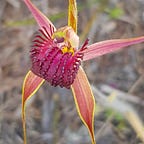What has Youern (Tiliqua rugosa) been eating?
Day 7 Koma (Patersonia) and the Hungry Blue Tongue
I’d already chosen Koma ( Noongar name for Patersonia occidentalis, purple flag, morning iris) for today’s flower, as the plant I was feeling most attuned to on my daily walk. There’s so many flies about I was fascinated by the pollinators, mainly hoverflies, on the 3 petalled Koma flowers.
Lizards are my favourite, so I stopped to say “Hi" to this local resident who lives high on the ridge. Her diet obviously includes Koma flowers. The Noongar name for this bobtail is Youern.
Circle of life, as a little while earlier , I’d come across the predigested remains of Lowlands Skinks.
On sunny mornings in Lowlands Coastal Reserve, Koma’s flower petals open the widest, making the most of early rising and pollinators, as well as adding lots of colour to my bushwalk. City of Albany uses blue Koma and pink Pimelia to great effect for mass plantings on Irrerup (Mt Adelaide).
I havent heard of Koma being bush tucker for humans, but Youern (bobtail) obviously enjoys the flowers as a treat. Koma plants are also an occasional part of kangaroos diet. Research shows the Koma leaves contain unusual flavinoids. https://www.sciencedirect.com/science/article/abs/pii/S0031942200978816 .
Noongar children made whistles out of Koma buds, and the straplike leaves are a useful weaving resource. Other Aboriginal uses of this plant include the use of its crushed stem as a fixative in ochre production. Keeps the ochre stronger in colour for body painting.
Youern (bobtail) are one of the totems of the Bilya clan of the Wadjuk people of the Noongar nation
My fundraiser for Bush Heritage #groundworkchallenge is going well . To join my team or donate go to https://www.groundworkchallenge.org.au/fundraisers/sheilamurray/2020?fbclid=IwAR2HbNn0YsCCc3tiSK-_lbF5xLsssaD8wjGHaUwVYrRqYxM-kdJkijoj2N0
Follow me on instagram @lowlandsbeach . https://www.instagram.com/lowlandsbeach/
and on twitter and linked in @lowlandsbeach https://twitter.com/lowlandsbeach and https://www.linkedin.com/in/sheila-murray-2730491bb/
Lowlands Coastal Reserve is managed by the local community and City of Albany. Bush Heritage manage lots of other wonderful reserves.
I am on Menang Boodja. I celebrate the strength, resilience and capacity of Noongar people who are the traditional owners of the land.
“The present survey of Patersonia has revealed an unusuaLly wide variety of flavonoid constituents in the genus. The finding of 6-hydroxyflavonoids and isoflavones is especially interesting, since these two classes are relatively rare in the family as a whole. Due to the structural richness encountered in the genus, it is not surprising that all 10 species examined may be easily distinguished by their leaf flavonoid patterns. The most similar profiles were those of P. maxwellii and P. occidentalis var. occidentalis, which are thought to be closely related species [9]. However, the flavonoid pattern of the broad-leaved typical P. occidentalis was so different from the narrow-leaved variety, var. ungustifoliu, that one wonders whether they should not be treated as two separate species.”
Tiliqua rugosa has conical teeth that tend to be relatively larger along the middle of the jaw, compared to the other teeth (Greer 1989; Shea 1990). This is believed to be an evolutionary adaptation for an omnivorous diet (Estes & Williams 1984). Although sleepy lizards are omnivores that primarily feed on plant material (see Appendix S2), and even have specific adaptations, such as caecal ridges in the colon, which are adaptations associated with herbivorous lizards (Herrel 2007). From long-term data collection, it has been determined that T. rugosa mainly feeds on the dominant available food (i.e. being opportunistic), so their diets tend to vary seasonally, and they favour a varied diet and thus consume different food items each day (Dubas & Bull 1991). They also do not usually consume all the available food, but feed for a short while, and then move several metres to feed in a different locality, even when food is still available in the initial locality (Dubas & Bull 1991, 1992; Henle 1990).
Priming, a form of female coercion in which the female can only become receptive after repeated courtship (How & Bull 2002). An evaluation of data from multiple years supports the assumption that it is a form of female coercion (Bull 2000). The female benefits energetically since there are indications that the males will defend the female from rival males (Bull & Pamula 1996; Kerr & Bull 2002; Murray & Bull 2004) and act as a sentinel for potential threats (Bull & Pamula 1998), both which permits the attended female to feed more effectively
